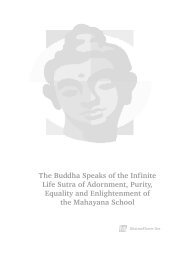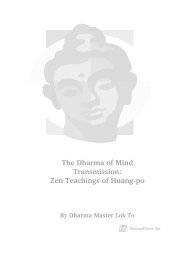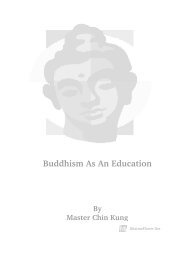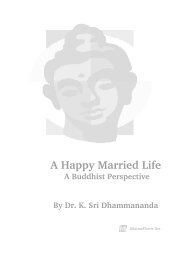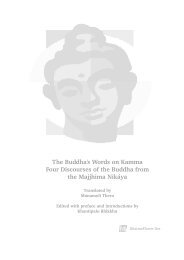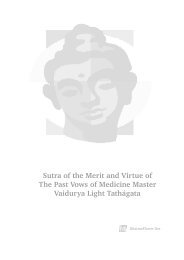Vipassana Meditation : Lectures On Insight Meditation by Venerable
Vipassana Meditation : Lectures On Insight Meditation by Venerable
Vipassana Meditation : Lectures On Insight Meditation by Venerable
Create successful ePaper yourself
Turn your PDF publications into a flip-book with our unique Google optimized e-Paper software.
2. Mindfulness of feeling or sensation (Vedananupassana Satipatthana)3. Mindfulness of Consciousness (Cittanupassana Satipatthana)4. Mindfulness of mind-objects (Dhammanupassana Satipatthana)Choice-less AwarenessWhen we are mindful of our mind-body process, we do not need to choose anymental or physical process as the object of our meditation. The mind willchoose the object <strong>by</strong> itself. If we choose any mental or physical process as theobject of meditation, it means we are attached to it. During meditation, the'noting mind' or the 'observing mind' will choose the object <strong>by</strong> itself; perhaps afeeling of happiness for our success, or a painful sensation, or the abdominalmovement. Though we try to focus the mind on the abdominal movement, themind does not stay with it if the pain is more distinct or more prominent. The'noting mind' will go to the pain and observe it because the more distinctfeeling takes the mind toward it very strongly. So we need to choose the objectbut should observe the object that the mind chooses. When pain disappearsthrough attentive and close awareness, the mind will choose another objectwhich is more distinct. If the itchy sensation on the back is more distinct ormore pronounced than the abdominal movement, the mind will go to thefeeling of itchiness and observe it as 'itching', itching, itching'. When the itchysensation has disappeared <strong>by</strong> means of strong mindfulness and deepconcentration, the mind will choose (for example) the abdominal movement asits object because it is more distinct than the other objects. If happiness is moredistinct than the abdominal object, the mind will choose happiness as its objectand observe it as 'happy, happy, happy'. So the principle of <strong>Vipassana</strong>meditation or mindfulness meditation is to observe, to watch, or to be mindfulof all mental or physical phenomena as they really are. This mindfulnessmeditation is not only very simple and easy, but also very effective in achievingour goal - the cessation of suffering.When we are taking food, we should be aware of every action, everyactivity involved in the act of eating. When we stretch out our arm, we must beaware of the movement of stretching. When the hand touches the spoon or therice, the touching sensation must be observed. When we hold the spoon, thesensation of holding must be observed. When we dip the spoon into the curry,that dipping movement must be observed. When we scoop curry with thespoon, that movement must be observed. In this way, each and every actioninvolved in the act of eating must be observed as it is because every physicalprocess must be thoroughly realized so as to remove ignorance, which is thecause of false view. In the same way, when we are taking a bath; while we areworking in the office or at home, we must be aware of all the actions ormovements involved. When practicing walking meditation in a retreat, themovements of the foot such as the lifting movement, the pushing movement6



